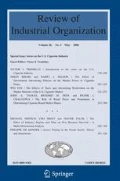Abstract
This paper discusses trust and trust perceptions in infrastructure contracts and supporting institutions. We focus on perceptions of the trustworthiness of the government purchasers of infrastructure services by the supplying companies and by the governments themselves. In particular, we allow for trust updating and trust misalignments, which may give rise to ‘undertrusting’ and ‘overtrusting’. The core of the paper sets out a game theoretic model of contracts with dynamic adjustment of trust perceptions, which we use to explore the impact of trust misalignment both on economic efficiency (measured by expected welfare) and on investment levels. We explore flexible contracts with and without pre-payments, rigid contracts (which do not allow for post-investment renegotiation), and hybrid contracts. We then compare the efficiency of the flexible contracts to that of hybrid contracts using as a criterion the expected welfare implications of each contract. The model is used to shed light on current issues on the sustainability of private investment infrastructure contracts in developed and in developing countries, including the role of regulatory institutions.
Similar content being viewed by others
References
Anderson, J., & Young, L. (2006). Trade and contract enforcement. The B.E. Journal of Economic Analysis & Policy, 5(1) (Contributions), article 30.
Araujo, L., & Ornelas, E. (2007). Trust-based trade. Retrieved from http://ssrn.com/abstract=642803.
Athias, L., & Saussier, S. (2006). Contractual design of toll adjustment provisions in infrastructure contracts. Atom-U, Paris-Sorbonne. Retrieved from http://ssrn.com/abstract=828944.
Aumann R. (1976) Agreeing to disagree. The Annals of Statistics 4: 1236–1239
Bolt, C. (2003). Regulating the London underground. Beesley Lecture. Retrieved from Web site http://www.ppparbiter.org.uk.
Bolt, C. (2007). Regulating by contract and by licence—The relationship between regulatory form and its effectiveness. CRI Bath and Web site http://www.ppparbiter.org.uk.
Braynov S., Sandholm T. (2002) Contracting with uncertain level of trust. Computational intelligence 18(4): 501–514
De Brux, J. (2008). The dark and blue sides of renegotiation: An application to transport concession contracts. Centre d’ Economie de la Sorbonne, Universitė Paris 1 Panthėon Sorbonne.
Greif A. (1993) Contract enforceability and economic institutions in early trade: The Maghribi traders coalition. American Economic Review 83(3): 525–548
Greif A. (2006) Institutions and the path to the modern economy: Lessons from medieval trade. Cambridge University Press, New York
Guasch J. L. (2004) Granting and renegotiating concession contracts: Doing it right. WBI Development Studies, World Bank Institute, Washington D.C.
Guasch J. L., Straub S. (2006) Renegotiation of infrastructure concessions: An overview. Annals of Public and Cooperative Economics 77(4): 479–493
Laffont J. J. (2005) Regulation and development. Cambridge University Press, Cambridge
Littlechild S. L. (2002) Competitive bidding for a long-term electricity distribution contract. Review of Network Economics 1(1): 1–38
Macaulay S. (1963) Non contractual relations in business. American Sociological Review 28(1): 55–70
McMillan J., Woodruff C. (1999) Interfirm relationships and informal credit in Vietnam. Quarterly Journal of Economics 114: 1285–1320
McMillan M.S., Waxman A. (2007) Profit sharing between host countries and multinationals in natural resource extraction: An empirical investigation. Brookings Trade Forum 2007: 149–175
Menard, C., & Saussier, S. (2002). Contractual choice and performance: Water supply in France. In E. Brousseau & J. M. Glachant (Eds.), The economics of contracts: Theories and applications (pp. 440–463). Cambridge University Press.
Myerson R. B. (1979) An axiomatic derivation of subjective probability, utility, and evaluation functions. Theory and Decision 11: 339–352
Spiller, P. (2004). An institutional theory of public contracts. ISNIE Conference 2004.
Spiller, P. T. (2008). An institutional theory of public contracts: Regulatory implications. National Bureau of Economic Research, working paper 14152. Retrieved from http://www.nber.org/papers/w14152.
Stern J. (2003) Regulation and contracts: Substitutes or complements?. Lessons from UK historical experience. Journal of Policy Reform 6(4): 193–215
Stern, J. (2005). Regulation and contracts: The inevitability of discretion. CCRP Workshop, Barcelona, Spain.
Tirole J. (2009) Cognition and incomplete contracts. American Economic Review 99(1): 265–294
Williamson O. E. (1976) The economics of internal organization: Exit and voice in relation to markets and hierarchies. American Economic Review 66(2): 369–377
Author information
Authors and Affiliations
Corresponding author
Rights and permissions
About this article
Cite this article
Dassiou, X., Stern, J. Infrastructure Contracts: Trust and Institutional Updating. Rev Ind Organ 35, 171–216 (2009). https://doi.org/10.1007/s11151-009-9221-4
Published:
Issue Date:
DOI: https://doi.org/10.1007/s11151-009-9221-4



